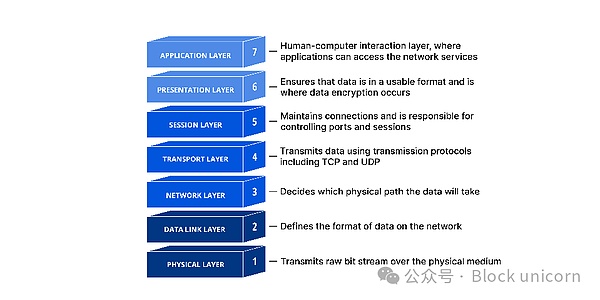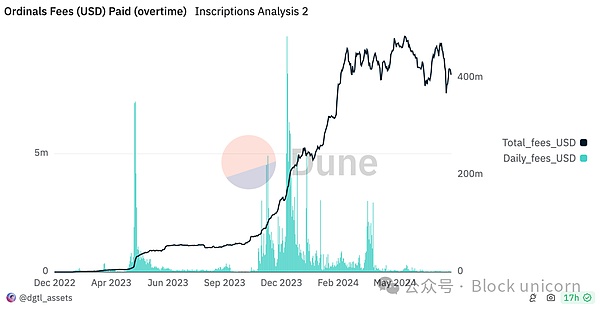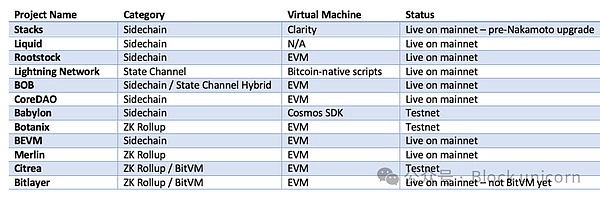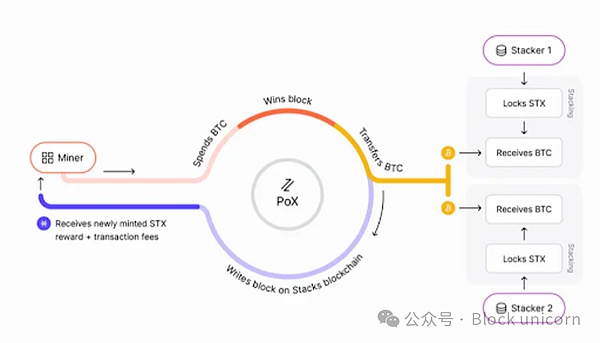Author: Leeor Shimron Translator: Block unicorn
An increasingly important theme in this round of crypto bull market cycle is the rise of Bitcoin L2. Bitcoin is generally regarded as the largest, most decentralized, and most secure crypto asset, with more than 100 million global holders and a market value of $1.2 trillion.
However, as a technology platform, it also has some limitations, such as slow transaction speed (block confirmation time is about 10-30 minutes), low scalability (can only process about 7 transactions per second), and limited programmability (its scripting language and smart contract functions are relatively limited).
Historically, the most successful technology networks have often been built and expanded in layers, which is particularly evident in the development of the Internet. The layered approach to the Internet is known as the Open Systems Interconnection Model (OSI Model), which includes seven layers: physical layer, data link layer, network layer, transport layer, session layer, presentation layer, and application layer. Every time an end user accesses an email or posts a comment on a social platform, these technologies are running and interacting in the background without the user knowing.
The OSI model outlines the layers of the Internet stack
Likewise, in order to address Bitcoin’s limitations while still inheriting its valuable network security and decentralization, the Bitcoin ecosystem is actively developing Bitcoin’s second-layer networks. These projects have sparked a renaissance in development and programmability, bringing decentralized finance (DeFi), NFTs, gaming, and other use cases that have flourished in competing blockchain ecosystems to Bitcoin.
This layered approach is in stark contrast to integrated blockchains that attempt to provide all of a blockchain’s core functions (consensus, data availability, execution) at the base layer. Blockchains like Solana, Near, and Algorand are designed to scale and provide high-performance computing without offloading data availability or execution to other networks, unlike the “modular” approach taken by Bitcoin and Ethereum.
Total value locked (TVL) is the main metric for measuring the growth of DeFi in a particular ecosystem. It represents capital deployed in various ways, such as lending assets to earn yield, providing liquidity in a pool, and using it as collateral to obtain on-chain credit. Although the development of Bitcoin's second-layer network has enabled DeFi application scenarios to flourish on Bitcoin, its growth is still limited. In comparison, more mature ecosystems such as Ethereum are ahead.
Currently, the total value locked (TVL) in decentralized finance (DeFi) on the leading Bitcoin layer 2 network is approximately $1.5 billion. This number may seem large, but it only accounts for 2% of Ethereum's current locked value of $81.3 billion. In addition, if you look at the ratio of TVL to network market value, Bitcoin's ratio is only 0.13%, while Ethereum's ratio is as high as 27%.
Considering that there is over $1 trillion in potential value stored in Bitcoin, there is a huge market opportunity for the leading Bitcoin layer 2 network to unlock this value for a variety of financial use cases. If Bitcoin’s DeFi growth reaches comparable proportions to Ethereum’s, this would represent $300 billion in deployable capital at current market prices.
Basic protocols and layer 2 solutions
Ordinals and Runes are base protocols on Bitcoin, launched in January 2023 and April 2024, respectively. The Ordinals protocol, in particular, has sparked greater interest in Bitcoin development and is often considered the catalyst for the start of "Bitcoin Season 2."
Base protocols like Ordinals and Runes operate directly on top of Bitcoin’s base layer without changing the core protocol. They embed additional functionality into Bitcoin transactions for applications that can be built directly with Bitcoin’s existing scripting framework (like NFTs and meme coins minted at a single satoshi).
In contrast, Bitcoin layer 2 solutions run on separate blockchains that are anchored to Bitcoin. They typically use Bitcoin’s security to ensure finality, but provide more complex functionality through their own consensus mechanisms.
Layer 2 solutions enable smart contracts, decentralized applications (dApps), and cross-chain interactions, often with their own tokens (such as DeFi, games, social media, and other applications that require more complex logic).
Whether it is the base protocol or the second-layer solution, both approaches aim to enhance the utility of Bitcoin by enabling new use cases and applications, which will drive an increase in demand for Bitcoin block space. This increase in demand will in turn increase transaction fees on the Bitcoin base layer, which is critical to maintaining Bitcoin's security model, especially as the block subsidy decreases every four years due to halving.
Network fees generated by ordinals and inscriptions
Ordinals have caused Bitcoin’s transaction fees to surge several times over the past two years, but so far, Ordinals has not become a sustainable source of fee income for Bitcoin miners. Since the most recent fee surge during the April 2024 halving, the average daily transaction fees minted by Ordinals have fallen 98.8% from about $2 million to just about $25,000 today. To maintain healthy transaction fees in the long term, other Bitcoin layer-2 projects need to make greater progress.
Low-value transactions such as micropayments, gaming, or DeFi require low transaction fees. Only layer-2 solutions can keep transaction fees low enough to make these economic activities viable while still generating more revenue for miners. In contrast, meta-protocols would inflate the state of Bitcoin, driving up transaction fees on the base layer, thereby excluding such transactions.
It is worth noting that many of the underlying protocols are not new to Bitcoin, and multiple such protocols have appeared in the Bitcoin network in history. Omni Layer (formerly Mastercoin) was launched in 2013 and allows the issuance of new tokens and stablecoins such as Tether. Counterparty was launched in 2014 and also allows the issuance of new tokens and decentralized applications. Rootstock was launched in 2018 and is a smart contract platform that merges mining with Bitcoin.
The next era of Bitcoin’s second-layer network
In recent years, we have witnessed dozens of new projects joining the “Bitcoin Season 2” narrative and claiming to integrate Bitcoin in some way. Recent examples include Build on Bitcoin (BOB), Bitlayer, CoreDAO, Babylon, Botanix, Merlin, BEVM, Citrea, etc. These new entrants, along with existing pioneers such as Stacks, Lightning Network, and Rootstock, have pushed the boundaries of the space.
The ultimate goal of these projects is to enable open and permissionless applications to leverage the value of Bitcoin holders in a trust-minimized manner. For example, imagine being able to lend your Bitcoin to earn native Bitcoin yield, or use your Bitcoin as collateral to obtain credit, or mint stablecoins backed by the value of Bitcoin without having to worry about cross-chain risks or losing your Bitcoin to a second-layer network.
The key to determining whether a Bitcoin layer is a "real second-layer network" is whether users can unilaterally exit while using these applications. This means that users can bridge their Bitcoin from the Bitcoin second-layer network back to the Bitcoin base layer without requiring any permissions. A true Bitcoin second-layer network also fully inherits the security of Bitcoin and benefits from the computing power generated by miners on the network.
Currently, the only protocols that enable unilateral exits are Lightning Network and statechain. Other protocols such as sidechains and rollups currently have limitations in bridging and do not meet this criteria. However, the proposed bridge protocol is an improvement over the status quo and paves the way for more flexible second-layer designs.
Bitcoin second-layer projects follow different frameworks with different trust assumptions, with the main structures being sidechains, state channels, ZK rollups, or optimistic rollups (BitVM). Here is an overview of each framework and their trust assumptions and limitations:
Sidechain: An independent blockchain, typically with its own token, consensus mechanism, and validator set, connected to the main blockchain to allow assets to be transferred between the two while enabling additional functionality and scalability.
Trust assumptions: Relying on a multi-signature contract controlled by the core team, through a centralized management bridge between the Bitcoin base layer and the second layer solution, the state and transaction finality of the Bitcoin base layer are verified by the sidechain rather than the Bitcoin base layer.
State channels: off-chain transaction method that allows participants to conduct multiple operations privately and instantly, broadcasting only the final state to the main blockchain, thereby enhancing scalability and reducing fees, but requiring trust in the cooperation between participants and preventing fraud. Usually does not have its own token or consensus mechanism.
Trust assumptions: Assume that participants will cooperate off-chain, continuously monitor the blockchain to prevent fraud, rely on sufficient liquidity and honest node operators, and trust effective dispute resolution mechanisms to close channels.
ZK-Rollup: A scaling solution that batches multiple transactions off-chain and generates succinct cryptographic proofs that are then verified on-chain to ensure correctness and security, while significantly reducing the data and computational burden on the main blockchain.
Trust Assumptions: Due to the inability to perform ZK verification on Bitcoin, the involvement of a centralized orderer, the reliance on a decentralized network of validators to accurately verify transactions checked by provers, and the need to publish data back to Bitcoin, rollups are limited in transaction processing capabilities.
BitVM: Similar to optimistic rollups on Ethereum, BitVM is a conceptual framework that breaks down contracts into logic gates and uses fraud proofs for trustless execution. As a new conceptual framework, BitVM has not yet been adopted by any blockchain in production, and the first solutions are expected to go live in early 2025.
Trust Assumptions: Assuming its trustless bridging mechanism, using basic computing units to allow fraud provers to detect inaccuracies will work effectively, but faces economic challenges as operators must match the bridged liquidity with an equal amount of collateral, making scalability difficult.
Classification of L2:
Upcoming Catalysts
Let’s take a look at a few of the leading Bitcoin layer 2 networks and some of their upcoming developments.
Stacks is a leading Bitcoin layer 2 network that first launched mainnet in January 2021, allowing the creation of smart contracts anchored to Bitcoin. Stacks supports a growing ecosystem of dApps, DeFi platforms, NFTs, and other blockchain-based applications, all of which are secured by Bitcoin's underlying network.
Stacks’ DeFi ecosystem has been growing steadily, including core protocols such as the liquid staking protocol (Stacking DAO), lending marketplaces (Zest Protocol), decentralized exchanges (Bitflow, Velar), and crypto-backed stablecoins (Arkadiko, Hermetica, BSD).
What makes Stacks unique is its Proof of Transfer (PoX) consensus mechanism. Stacks miners compete for the right to mine new Stacks blocks by consuming Bitcoin and are rewarded with STX. STX holders can also participate by locking their STX tokens and receiving BTC rewards. Historically, the annualized return for STX token holders participating in the consensus has been around 8%.
Stacks Proof of Transfer (PoX) consensus mechanism diagram
Stacks is about to undergo a major upgrade called the Nakamoto Upgrade, which will bring several improvements to the protocol. The upgrade, expected on August 28, aims to bring true Bitcoin finality to Stacks transactions. This means that once a Stacks transaction is confirmed and anchored to the Bitcoin blockchain, it will gain the same security and immutability as Bitcoin transactions.
The upgrade will also strengthen the integration between Stacks and Bitcoin, ensuring that any reorganization of Stacks blocks will require a reorganization of Bitcoin blocks, significantly increasing the security of Stacks transactions.
In addition, the upgrade introduces sBTC, a Bitcoin-equivalent token on the Stacks network that will be backed by BTC at a one-to-one ratio. This enables users to use Bitcoin directly in the Stacks ecosystem, enabling more seamless integration with Bitcoin liquidity and enhancing the utility of BTC in smart contracts and dApps.
These features make Stacks, especially after the Satoshi upgrade, a more pure second-layer Bitcoin solution than many other projects by more fully leveraging Bitcoin's security, economic model, and decentralization.
Build on Bitcoin (BOB) and Botanix are two other leading Bitcoin layer 2 projects that have taken a different approach from Stacks. BOB is the first hybrid layer 2 network powered by both Bitcoin and Ethereum. BOB's rollup ecosystem aims to leverage the security of Bitcoin while giving users access to all the features provided by the Ethereum Virtual Machine (EVM), such as in-and-out channels, stablecoins, NFTs, DeFi, and more.
BOB has completed the first phase of its roadmap, including launching optimistic ETH rollups using the Optimism (OP) framework. Settlements occur on Ethereum Layer 1, while BOB tracks the state of Bitcoin through a Bitcoin light client, enabling cross-chain swaps and contracts to be executed between Ethereum and Bitcoin.
The first phase was launched on May 1, supporting Sovryn DEX, LayerBank lending market, Velodrome DEX, etc. Future phases will introduce Bitcoin Proof of Work security to ETH rollups, and ultimately BOB’s roadmap will end with its own BitVM rollup implementation.
Alexei Zamyatin, co-founder of BOB, said: "BOB is already live on the mainnet and has a growing ecosystem. We work closely with the team to prioritize solving product problems rather than talking about cool technology or pushing up the total locked volume (TVL) through unsustainable incentives."
“We bring new technologies on Ethereum to Bitcoin, including Intents (BOB Gateway, one-click BTC deployment) and Smart Accounts (BOB Pay, send BTC via email or Telegram without a wallet). Through BOB Gateway, BOB is the most convenient way to get from BTC to Wrapped BTC, BTC Liquid Staking Tokens, and soon, BTC Yield Positions.”
Botanix Labs aims to build the first fully decentralized EVM-equivalent layer-2 network on top of Bitcoin. Leveraging Bitcoin as a base layer for settlement and decentralization, Botanix will use a proof-of-stake consensus model where stake (expressed in Bitcoin) will be securely stored on Spiderchain, a decentralized distributed network of multi-signature contracts secured by a random subset of participants.
Willem, founder of Botanix Labs, said: "Botanix runs entirely on Bitcoin, which means it is not connected to any other chain and gas fees are paid in Bitcoin. It is different from rollups in that there will be a decentralized sorter consisting of 15 different node operators on day one, while rollups adopt a more centralized single operator model. Botanix will have extremely low gas fees and censorship resistance."
Botanix launched its testnet in November 2023 and currently has over 200,000 active addresses. Although its mainnet is not yet online, users can still interact through Botanix's testnet, allowing users to connect wallets, receive funds, and enter and exit the Botanix network. The mainnet is expected to be launched in September, and partners that have been announced include Frax, Vertex, Kiln, and Supra Oracles.
Both BOB and Botanix leverage the EVM to enable the creation and execution of smart contracts. This ensures compatibility with development tools and infrastructure already built on Ethereum, such as wallets, block explorers, data analysis tools, and consumer applications. This enables developers, tools, and applications to be easily ported to their respective ecosystems.
In contrast, Stacks developed the Clarity Virtual Machine and took a first-principles approach to growing its developer community. This has a higher learning curve for blockchain developers, but can more easily attract developers who are already familiar with Web 2.0-friendly technologies. It remains to be seen which approach will better encourage developer adoption in the long run.
The future is Bitcoin
The emergence of Bitcoin’s second-layer networks marks an important evolution in the blockchain ecosystem. These solutions aim to address Bitcoin’s inherent limitations by leveraging Bitcoin’s strong security and decentralization features while enabling widespread adoption and enhanced functionality.
The development of Bitcoin’s second layer network and meta-protocol together represents a promising path to unlocking the enormous value inherent in Bitcoin, potentially transforming it into a more diverse and powerful financial platform.
As these projects continue to mature and integrate seamlessly with Bitcoin, they are expected to drive significant advances in the crypto space, making Bitcoin more scalable, programmable, and able to support a variety of use cases.














